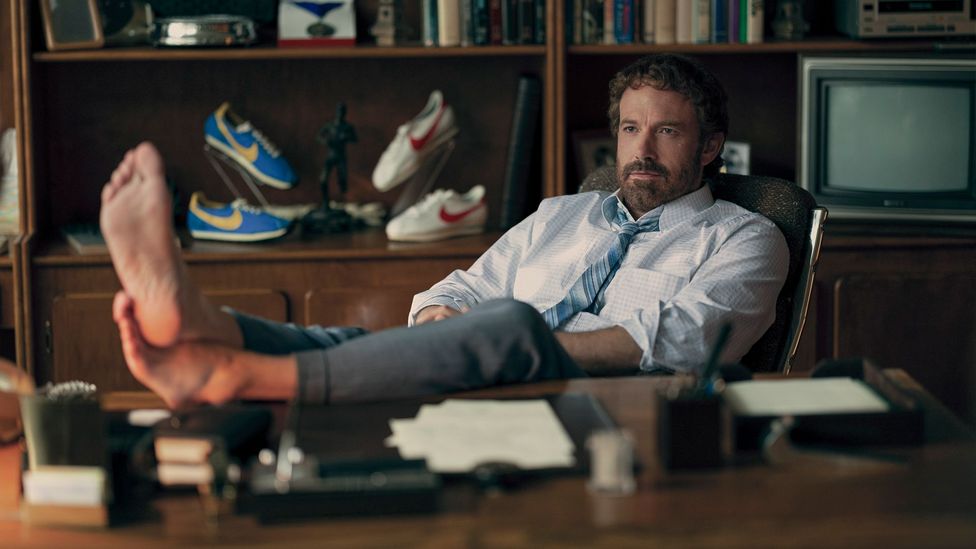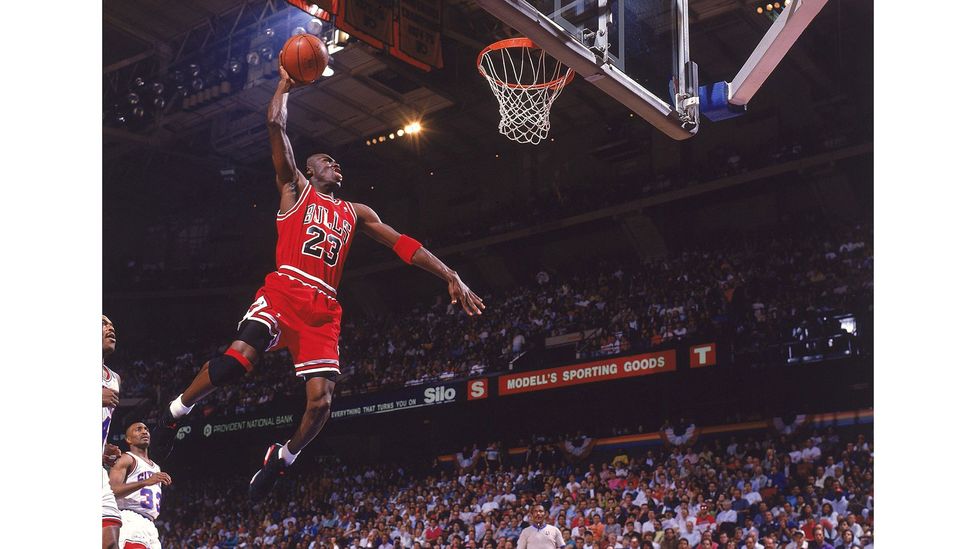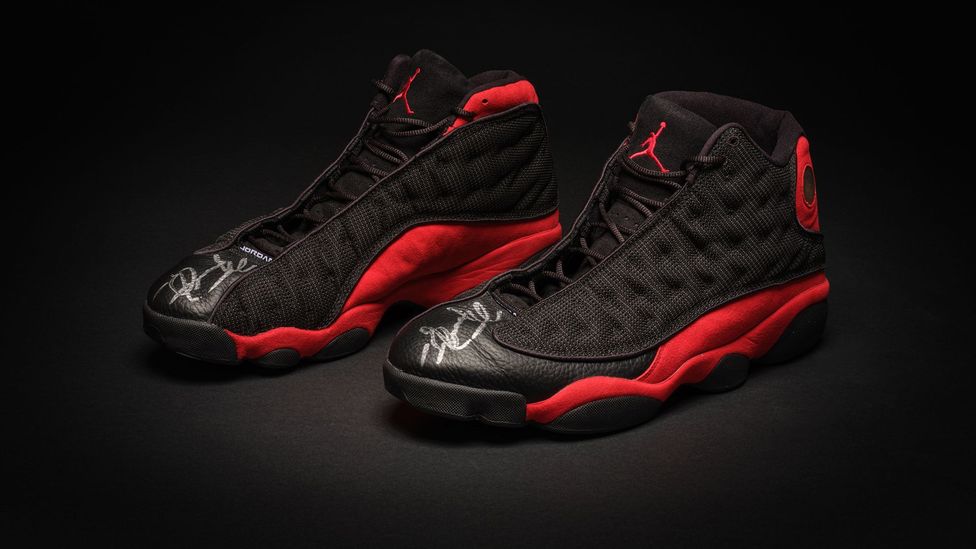Why are Air Jordans so valuable?
As the Ben Affleck movie Air premieres, starring Matt Damon and Viola Davis, the original sneakers are being auctioned. Ellie Violet Bramley explores the unstoppable rise of the ultimate cult shoe.For a pair of second-hand trainers to be expected to sell for somewhere in the region of $2 million to $4 million, they must be pretty special. Next week, a pair of Nike Air Jordan 13s worn by Michael Jordan in the second game of the NBA finals in 1998, a season colloquially known as "the last dance", are to be auctioned by Sotheby's and are the most valuable sneakers to ever appear on the market. "At the time [of the game] the Bulls were cognisant that they were going to be disbanded as a team, they were aware that this was their last chance at winning an NBA championship together," Brahm Wachter, Sotheby's head of streetwear and modern collectables, tells BBC Culture. "The pair that we have is actually the only MeiGray photo-matched pair (MeiGray is the authenticator for the NBA) from any of the NBA finals that have ever appeared at auction." More like this: - What your sneakers say about you - The nasty truth about trainers - The rise of the minimalist wardrobe The current auction record for a pair of trainers at auction, according to Sotheby's, is $1.472m in 2021, also for a pair worn by Jordan. That the Jordan 13s are expected to eclipse this record amount speaks not only to their rarity but also to the incredible, lasting legacy of arguably the most iconic sneaker design ever created. "It's something that will appeal to sneakerheads, and will also appeal to game-worn collectors," says Wachter, meaning that they show signs of having graced Jordan's feet on court. "They definitely look worn but they are in really good condition considering how old they are." Ben Affleck's new movie Air tells the behind-the-scenes story of the Air Jordan sneaker (Credit: Warners)So what is it about the Air Jordan that makes it so special? The backstory alone, the subject of a new film, Air, directed by and starring Ben Affleck alongside Matt Damon and Viola Davis, was unprecedented. At the time that Nike approached Jordan, in 1984, he was still a rookie playing at the University of Carolina. Still, they had to fight to convince him to sign with them, as Jordan himself was keen to sign with Adidas and at the time Nike was a struggling brand. Shoe designer and Nike legend Peter C Moore was brought in, reportedly sketching the design on the back of a napkin, and the first Air Jordan was born. It was the first of 35 different Air Jordan designs that have been released in the years since. Jordan's athletic prowess is clearly a major factor in the shoe's enduring reputation. "Jordan's cultural cachet continues to increase even beyond his playing years," says Drew Haines, merchandising director of sneakers and collectibles at StockX, the online marketplace and resale site for streetwear and sneakers. "All this time has passed, and really no one has reached the level that he was able to reach in his career." Unmatched, too, is the mythology that developed around the man himself, and the way he managed to spring out of the court and into popular culture. "For many people it wasn't Christopher Reeve that made you think a man could fly, it was Michael Jordan, and he had no strings doing it," says Jian DeLeon, former editorial director of sneaker and streetwear magazine Highsnobiety. "He was actually doing it in real life over and over, and these were the shoes he was doing it in." Plus, Air Jordans "are eminently more wearable than Superman's cape or the underwear outside the pants." The trainers were, DeLeon tells BBC Culture, "a representation of a wearable manifestation of human greatness."A basketball legend, Michael Jordan was known for his ability to apparently 'fly' on court (Credit: Getty Images)A lot of the marketing around the shoes was more like that of a car promotion, says DeLeon, who's not sure of the exact number of pairs he owns – he acquired five or six in the past month, and has somewhere in the 100s in total. In 1989, adverts were released, "very Spike Lee style", as DeLeon puts it, in which Lee appears as Mars Blackmon, his character from his film She's Gotta Have It. In the ads, he questions Jordan on what makes him the best player in the universe, and repeatedly says, "it's gotta be the shoes!" Teaming up with Lee on the adverts was a savvy move. It was, says DeLeon, unprecedented for any brand to tap into the cultural zeitgeist like that. "I think that was the moment that, 'ok, these are a status symbol,'" he says. The shoe was initially banned by the NBA because of its red-and-black colour scheme at a time when the organisation stipulated that players' footwear had to be predominantly white. This inevitably only created a rebellious mystique around it – it is the shoe's ability to take colour that might also have helped in its long-lasting popularity. "Whether it was the toe box or the

For a pair of second-hand trainers to be expected to sell for somewhere in the region of $2 million to $4 million, they must be pretty special. Next week, a pair of Nike Air Jordan 13s worn by Michael Jordan in the second game of the NBA finals in 1998, a season colloquially known as "the last dance", are to be auctioned by Sotheby's and are the most valuable sneakers to ever appear on the market.
"At the time [of the game] the Bulls were cognisant that they were going to be disbanded as a team, they were aware that this was their last chance at winning an NBA championship together," Brahm Wachter, Sotheby's head of streetwear and modern collectables, tells BBC Culture. "The pair that we have is actually the only MeiGray photo-matched pair (MeiGray is the authenticator for the NBA) from any of the NBA finals that have ever appeared at auction."
More like this:
- What your sneakers say about you
- The nasty truth about trainers
- The rise of the minimalist wardrobe
The current auction record for a pair of trainers at auction, according to Sotheby's, is $1.472m in 2021, also for a pair worn by Jordan. That the Jordan 13s are expected to eclipse this record amount speaks not only to their rarity but also to the incredible, lasting legacy of arguably the most iconic sneaker design ever created. "It's something that will appeal to sneakerheads, and will also appeal to game-worn collectors," says Wachter, meaning that they show signs of having graced Jordan's feet on court. "They definitely look worn but they are in really good condition considering how old they are."

Ben Affleck's new movie Air tells the behind-the-scenes story of the Air Jordan sneaker (Credit: Warners)
So what is it about the Air Jordan that makes it so special? The backstory alone, the subject of a new film, Air, directed by and starring Ben Affleck alongside Matt Damon and Viola Davis, was unprecedented. At the time that Nike approached Jordan, in 1984, he was still a rookie playing at the University of Carolina. Still, they had to fight to convince him to sign with them, as Jordan himself was keen to sign with Adidas and at the time Nike was a struggling brand. Shoe designer and Nike legend Peter C Moore was brought in, reportedly sketching the design on the back of a napkin, and the first Air Jordan was born. It was the first of 35 different Air Jordan designs that have been released in the years since.
Jordan's athletic prowess is clearly a major factor in the shoe's enduring reputation. "Jordan's cultural cachet continues to increase even beyond his playing years," says Drew Haines, merchandising director of sneakers and collectibles at StockX, the online marketplace and resale site for streetwear and sneakers. "All this time has passed, and really no one has reached the level that he was able to reach in his career."
Unmatched, too, is the mythology that developed around the man himself, and the way he managed to spring out of the court and into popular culture. "For many people it wasn't Christopher Reeve that made you think a man could fly, it was Michael Jordan, and he had no strings doing it," says Jian DeLeon, former editorial director of sneaker and streetwear magazine Highsnobiety. "He was actually doing it in real life over and over, and these were the shoes he was doing it in." Plus, Air Jordans "are eminently more wearable than Superman's cape or the underwear outside the pants." The trainers were, DeLeon tells BBC Culture, "a representation of a wearable manifestation of human greatness."

A basketball legend, Michael Jordan was known for his ability to apparently 'fly' on court (Credit: Getty Images)
A lot of the marketing around the shoes was more like that of a car promotion, says DeLeon, who's not sure of the exact number of pairs he owns – he acquired five or six in the past month, and has somewhere in the 100s in total. In 1989, adverts were released, "very Spike Lee style", as DeLeon puts it, in which Lee appears as Mars Blackmon, his character from his film She's Gotta Have It. In the ads, he questions Jordan on what makes him the best player in the universe, and repeatedly says, "it's gotta be the shoes!" Teaming up with Lee on the adverts was a savvy move. It was, says DeLeon, unprecedented for any brand to tap into the cultural zeitgeist like that. "I think that was the moment that, 'ok, these are a status symbol,'" he says.
The shoe was initially banned by the NBA because of its red-and-black colour scheme at a time when the organisation stipulated that players' footwear had to be predominantly white. This inevitably only created a rebellious mystique around it – it is the shoe's ability to take colour that might also have helped in its long-lasting popularity. "Whether it was the toe box or the contrast on the swoosh or the collar, the way that you could design it and make colours pop was just eminently noticeable in a way that was relatively new to sneakers, and I think that was part of it," says DeLeon.
Cult appeal
Despite not owning any himself – "I'm very much a Nike Airforce guy" – Haines also nods to the design itself: "The cleanliness of the model, the way the panels are constructed and the way that they can apply hundreds or thousands of different colours to that, and different materials and keep it fresh, I think it's a versatile sneaker, for men, for women, for kids."
There have, of course, been other athletes with signature shoe lines before. DeLeon points to Adidas Stan Smiths, endorsed by the legendary US tennis player of the same name, as well as the signature basketball sneaker the Converse Chuck Taylor which, according to DeLeon was the "weapon of choice for athletes in the NBA" at the time the first Air Jordans were released. "But what made the Jordan line particularly interesting is the athlete has always managed to stay upfront and have more relevance than the shoe itself."
Often, after an athlete stops playing, their memory gets usurped by the trainer. When Smith collaborated with the late influential Parisian boutique, Colette and Adidas during the reintroduction of that shoe, which became the go-to trainer for fashion types in 2010s, Smith apparently opened the door to Colette, and there were "so many kids just rushing past him. They didn't recognise him. A book about the man and the trainer is literally called, Some People Think I'm a Shoe. "I don't think that's been the case with Jordans,” says DeLeon.
It didn't hurt that three years ago, Netflix's The Last Dance had basketball novices, who barely knew what a slam dunk was, gripped as they watched the 10-part documentary series charting the rise of the Chicago Bulls with Jordan at the helm. StockX saw an incredible spike in interest around that time in the summer of 2020.
Air Jordans are not without their controversies. 2020 documentary One Man and His Shoes delved into the way Nike aggressively marketed the shoes to the kids who could least afford them, as one reviewer wrote, "controlling the supply of Air Jordans as carefully as De Beers controlled the supply of diamonds, artificially assigning extreme value and desirability to the shoes".
It is no surprise that they were also the sneaker that arguably first kicked off sneaker culture as we now know it: "It's pretty clear to me at least that the Jordan 1 sneaker itself is probably the sneaker that started it all," says Haines. "It's the sneaker that started this feverish sneaker culture that has existed now for the better part of probably 20 years."

Sotheby's is auctioning a pair of Air Jordans, worn by the player at the NBA finals game in 1998 (Credit: Sotheby's)
They also, says DeLeon, "revolutionised street fashion. It was a shoe that had a cult appeal, you would see them on the street and if you were part of the tribe you could easily identify what they were, you could connect with people over them. That was the beginnings of street culture, knowing these codes, being able to connect over them," he says. They stood for something: "in the 80s or 90s if you saw Jordans on someone's feet there was a high chance that you could have a conversation starting with the shoes and leading into other similar interests, whether it was hip-hop, whether it was sports, whether it was burgeoning street rap brands like [hip-hop record label] QC, [Jordans] were like part of an underground uniform of this burgeoning style tribe."
While then they might have been cutting edge, now part of their appeal is nostalgia. For DeLeon, "I have an old Blur T-shirt or an Anime T-shirt that I'll never get rid of, [it's] the same thing with Jordans."
If you would like to comment on this story or anything else you have seen on BBC Culture, head over to our Facebook page or message us on Twitter.
And if you liked this story, sign up for the weekly bbc.com features newsletter, called The Essential List. A handpicked selection of stories from BBC Future, Culture, Worklife and Travel, delivered to your inbox every Friday.












